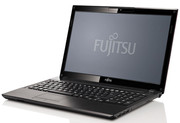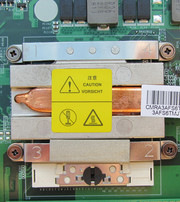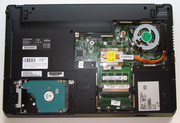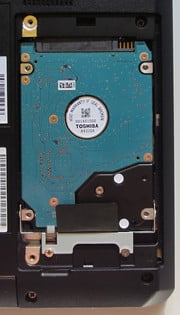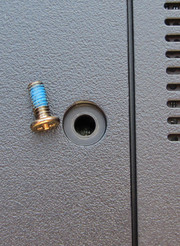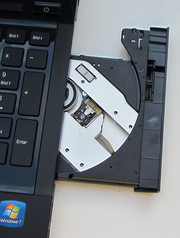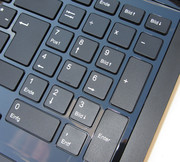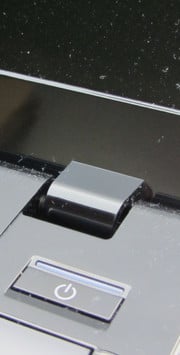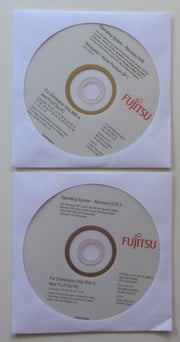富士通 LifeBook AH552/SL 笔记本
Fujitsu's Lifebook AH552/SL (SL stands for Slim Line) is a thinner and lighter weight 15.6-inch notebook than most in its class. Thanks to the 25.4 mm (one inch) case and a weight of 2.2 kg (4.85 pounds), it slots in between regular 15.6-inch notebooks and 15.6-inch Ultrabooks. Possible competition consists of the Acer Aspire V5-571G (Intel Core i5-3317U, Nvidia GeForce GT 620M) and low price models like the HP 655 (AMD E2-1800, AMD Radeon HD 7340).
Our test unit is powered by Intel's Core i5-3210M dual-core processor with 4 GB RAM at its disposal. Graphics output is taken care of by Intel's integrated HD-4000 GPU. Data and applications are stored on a 750 GB hard drive. A DVD writer is also available. Fujitsu also offers this laptop with various other component choices.
Connectivity
The left side of the system offers one USB 3.0 connector, one Gigabit Ethernet interface and two audio jacks for headphones and microphones. The VGA port will be useful if the notebook is supposed to be hooked up to a projector. HDMI is also available for connection to a television or external monitor. To the right, we find three USB 2.0 connectors, the optical drive and a power connector. The storage card reader (SD, SDHC, Memory Stick, Memory Stick Pro) has been conveniently placed at the front.
Display
Fujitsu chose a usual suspect for the display. The 15.6-inch display of the Lifebook AH552/SL makes do with a resolution of 1366x768 pixels. It uses LED backlight and glossy-type display surface. Other display options are not available. Illumination is good, at 94%, but display brightness should really be better than the 206.2 cd/m² average we measured.
Acer doesn't use a better display in the Aspire V5-571G either, with a poor average brightness of 177.6 cd/m² and evenness of illumination at 89%. The brightness of the HP 655 is even worse with 161.7 cd/m². Those looking for a notebook with a better display might have a look at Sony's SV-S1511X9E/B, which has a display that’s far ahead of the notebooks mentioned here, but it’s also more expensive.
| |||||||||||||||||||||||||
Brightness Distribution: 94 %
Center on Battery: 213 cd/m²
Contrast: 179:1 (Black: 1.19 cd/m²)36.83% AdobeRGB 1998 (Argyll 2.2.0 3D)
45.38% sRGB (Argyll 2.2.0 3D)
34.99% Display P3 (Argyll 2.2.0 3D)
The display's black value is mediocre at best at 1.19 cd/m², so it fails to render black or any dark colors for that matter. Contrast is also poor at 179:1. Acer's Aspire V5-571G does this slightly better with both the black value (0.97 cd/m²) and the contrast (193:1). HP's 655 falls behind noticeably compared to Fujitsu's display, delivering a lousy 1.4 cd/m² black value and contrast ratio of just 118:1. The Fujitsu Lifebook AH552/SL is not suited for image editing: its display is unable to render either the AdobeRGB or the sRGB color space.
Outdoor Use
Viewing Angles
The viewing angles of the Fujitsu Lifebook AH552/SL held no surprises either and matched our expectations. As soon as you leave a 90 degree vertical angle, the image breaks up. Horizontal angles are better, the image remains stable to very narrow angles, only brightness drops a little.
Performance
Fujitsu places the Lifebook AH552/SL in its "all rounder" category. According to Fujitsu, computers of this category offer "the ideal solution for reliable operation in office and home applications". In other words: The Fujitsu Lifebook AH552/SL is an office notebook. The fittings are suitable for the common tasks: web surfing, email, chat, Word and watching DVDs. Computer games can only be played in a very limited way. To use the system for image or video editing, one should upgrade RAM and buy a faster hard drive.
Fujitsu offers different equipment levels for the Lifebook AH552/SL with choices for different processors, hard drives and operating system versions. Fujitsu's website offers four different processors (Core i3-2350M, Core i3-3110M, Core i5-3210M, Core i7-3612QM) and five hard drive options (320 to 750 GB). Aside from Windows 7 Home Premium, Windows 7 Professional is also available. Additionally, you can choose to get it with a display lid colored red.
Processor
Our AH552/SL is equipped with Intel's Core i5-3210M dual-core processor from the new Ivy Bridge generation. The base clock speed is 2.5 GHz and can be clocked up as needed to 2.9 GHz for both cores or 3.1 GHz for a single core. The technology behind this automatic clock speed control is called Turbo Boost.
Both the Acer Aspire V5-571G and the Acer Aspire V5-531 sport ULV processors (Intel Core i5-3317U and Intel Pentium 967). A low voltage processor would be useful in the Lifebook AH552/SL as well. Mobility would be vastly improved: lower energy consumption, lower noise levels and longer battery runtimes.
During our full load tests (Prime95 and FurMark running simultaneously), both cores ran consistently at full speed (2.9 GHz) and the same held true for the GPU, there are no throttling issues. This did not change when running on battery either. Measurements while running Cinebench R11.5 provided the same result as well, both processor cores stayed clocked at 2.9 GHz. Very rarely, one of the processor cores spiked to 3.1 GHz for a fraction of a second. Performance scores roughly match the older Sandy Bridge based Intel Core i5-2520M. Our Core i5-3210M reached the performance of the older chip while running at a slower speed.
The two competing Acer notebooks can't keep up in the Cinebench test. The Acer Aspire V5-571G does manage to pull ahead in the OpenGL tests, because of its dedicated GeForce GT 620M GPU. The HP 655 unsurprisingly doesn't have a prayer; its AMD E2-1800 APU's performance doesn't even come close to the Core i5-3210M.
System Performance
Day to day performance is satisfying, applications run fluidly. Replacing the hard drive with a solid state drive would improve responsiveness considerably. PCMark benchmark results are as expected. Acer's Aspire V5-571G delivers a better PCMark Vantage result thanks to its GeForce GT 620M GPU. Once again, the HP 655 can't keep up with the Lifebook AH552/SL.
| PCMark Vantage Result | 5792 points | |
| PCMark 7 Score | 2485 points | |
Help | ||
Storage Devices
Fujitsu equipped the Lifebook AH552/SL with a conventional hard drive (MK7575GSX) from Toshiba. The drive spins at 5400 RPM and offers 750 GB of storage. This is more than sufficient for countless pictures, songs and videos. With average transfer rates of 75.1 MB/s, the Toshiba hard drive is typical for 5400 RPM hard drives. Generally, you could say that the hard drive is not a bottleneck, it fits well into the overall system. Those who need more speed can easily swap the hard drive for a solid state drive. Aside from the 750 GB drive, Fujitsu also offers 320 GB and 500 GB models. Both sizes are available in 5400 RPM and 7200 RPM versions.
Graphics Card
Like the CPU, the HD-4000 GPU unsurprisingly also comes from Intel, since it is integrated into the Core i5-3210M processor. The Intel HD-4000 is dynamically clocked between 350 and 1100 MHz and supports DirectX 11. It represents Intel's current best GPU and is equipped accordingly. For everyday use, the 3D performance and the integrated video decoder are probably of the highest interest. We tested the video decoder playing back H.264 Full-HD (1080p) videos, which did not pose any challenge; playback was perfectly smooth. CPU load remained at 10%.
In 3DMark, the Fujitsu Lifebook AH552/SL delivered the same results as other notebooks sporting the HD-4000 GPU. Generally, this GPU is in the lower middle class range - it can't touch the results of Nvidia's GeForce GT 620M in Acer's Aspire V5-571G. The HP 655 (AMD Radeon HD7340) on the other hand fails to challenge the Fujitsu notebook, which isn't much of a surprise.
| 3DMark 03 Standard | 9766 points | |
| 3DMark 05 Standard | 7267 points | |
| 3DMark 06 Standard Score | 4228 points | |
| 3DMark Vantage P Result | 2895 points | |
| 3DMark 11 Performance | 588 points | |
Help | ||
Gaming Performance
The Fujitsu Lifebook AH552/SL is not a notebook for passionate gamers. Playable frame rates are only reached at low resolution and low detail settings. Those who only play simple games every few weeks may be satisfied with the gaming performance. The Acer Aspire V5-571G is less likely to earn gamers' scorn, it manages playable frame rates in medium and sometimes high detail settings in the native 1366x768 resolution.
| low | med. | high | ultra | |
|---|---|---|---|---|
| StarCraft 2 (2010) | 96.2 | 24.69 | 13.14 | |
| Deus Ex Human Revolution (2011) | 37.48 | 16.67 | ||
| The Elder Scrolls V: Skyrim (2011) | 27 | 13.28 | 7.74 |
System Emissions
In everyday use, Fujitsu's Lifebook AH552/SL is a quiet companion. At idle, the fan often deactivates completely, leaving only the sound of the hard drive. It does get a bit louder when reading from the optical drive, but at 34.3 dB(A) it is still not disconcerting. Under full load however, the machine gets loud. During our load test (Prime95 and FurMark running simultaneously), we measured 43 dB(A) and this level of noise is clearly in the annoying range. With medium load, (3DMark 2006) we measured 38.1 dB(A). Acer's Aspire V5-571G reaches similar noise levels. HP’s 655 model produces a little less noise under load, but instead, it’s noisier at idle.
Noise Level
| Idle |
| 30.6 / 31.9 / 32.6 dB(A) |
| HDD |
| 32.6 dB(A) |
| DVD |
| 34.3 / dB(A) |
| Load |
| 38.1 / 43 dB(A) |
 | ||
30 dB silent 40 dB(A) audible 50 dB(A) loud |
||
min: | ||
Temperatures
At idle, operating temperatures everywhere are low. Topside as well as below, temperatures are mostly between 30 and 35 degrees Celsius, only two measuring points got slightly higher than that. These temperatures permit comfortable working, and placing the laptop on your lap is no problem. Under load, temperatures rise over 40 degrees Celsius, one measurement point even reached 53 degrees Celsius. The temperature of the wrist rest still remains cool enough to work comfortably.
During our stress tests (Prime95 and FurMark running for at least one hour), both cores consistently ran at full speed (2.9 GHz) and the same held true for the GPU. When running on battery, no change was observed. Hence, we conclude there is no throttling issue. Temperatures honed in on 87 to 88 degrees Celsius.
(-) The maximum temperature on the upper side is 49.6 °C / 121 F, compared to the average of 34.3 °C / 94 F, ranging from 21.2 to 62.5 °C for the class Office.
(-) The bottom heats up to a maximum of 53 °C / 127 F, compared to the average of 36.8 °C / 98 F
(±) In idle usage, the average temperature for the upper side is 32.4 °C / 90 F, compared to the device average of 29.5 °C / 85 F.
(-) The palmrests and touchpad can get very hot to the touch with a maximum of 41 °C / 105.8 F.
(-) The average temperature of the palmrest area of similar devices was 27.6 °C / 81.7 F (-13.4 °C / -24.1 F).
Energy Consumption
If the Fujitsu Lifebook AH552/SL is just used for fetching emails, its very frugal with its use of electricity. At idle, we measured its power draw hovering between 8.8 and 10.9 Watts. Under full load (Prime95 and FurMark running simultaneously) power draw climbs rapidly to 50.4 Watts. The included 65 Watt power supply capacity is well sized and never gets pushed past 80%.
Fujitsu gives away potential here, because no ULV processor is available. Acer's Aspire V5-571G uses slightly less power under full load, in spite of its dedicated GPU. At idle, it also uses less power than the Lifebook.
| Off / Standby | |
| Idle | |
| Load |
|
Key:
min: | |
Battery Runtime
The Fujitsu Lifebook AH552/SL runs for 7:15 hours at idle, when tested with the Battery Eater Reader's test (minimum display brightness, all wireless radios deactivated). Under load, the Fujitsu notebook falters after a run time of 1:09 hours running the Battery Eater Classic test (maximum display brightness, high performance profile, wireless radios activated).
In the real world Wi-Fi browsing test, the notebook lasted 4:15 hours. During this test, a script calls up various web pages with a 40 second interval (150 cd/m² display brightness, energy savings profile, Wi-Fi radio activated). For the DVD playback test, the Lifebook managed 3:36 hours, which is enough to watch two movies (maximum display brightness, wireless radios deactivated, energy savings profile or higher, if playback stutters).
The Aspire V5-571G can't keep up with the battery runtimes of the Lifebook AH552/SL, which is no surprise: Acer's battery capacity of just 37 Wh is about three quarters of Fujitsu's 48 Wh capacity. The HP 655 however beats the Lifebook in all but the idle test.
Verdict
In closing, we can confirm Fujitsu offers a sound computer system. At prices around 570 to 600 Euro (~$717 to $755), buyers receive what can be expected at this price: A good looking notebook which is a little thinner and lighter than most 15.6-inch notebooks. The aluminum display lid helps it look expensive. Performance of Intel's Core i5 processor is more than enough for home use. The Toshiba hard drive offers a good deal of room for personal files. The notebook doesn't shine in any particular area, but it doesn't fail any of our tests either.






























